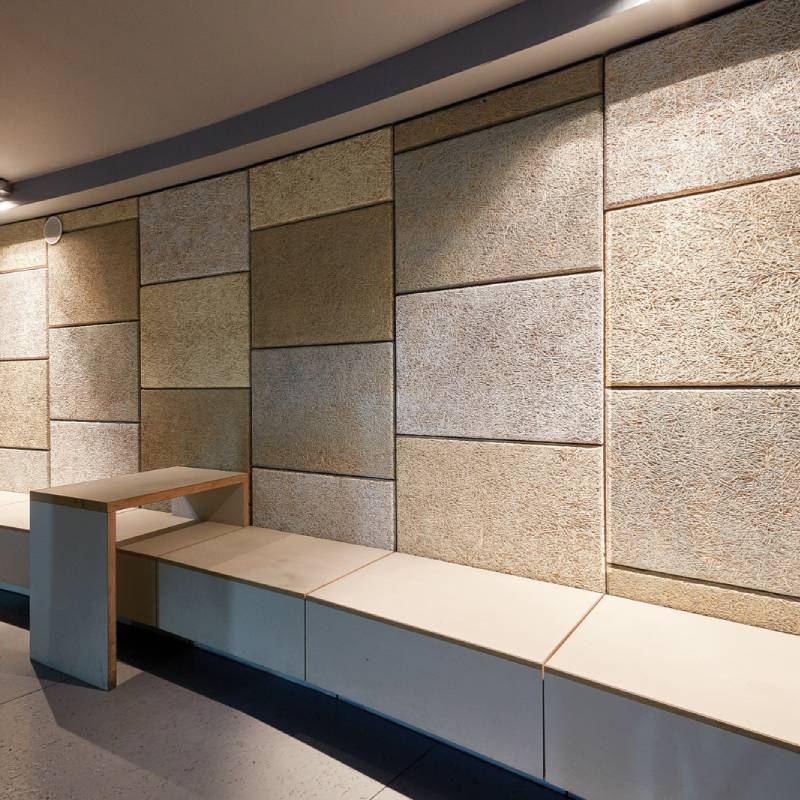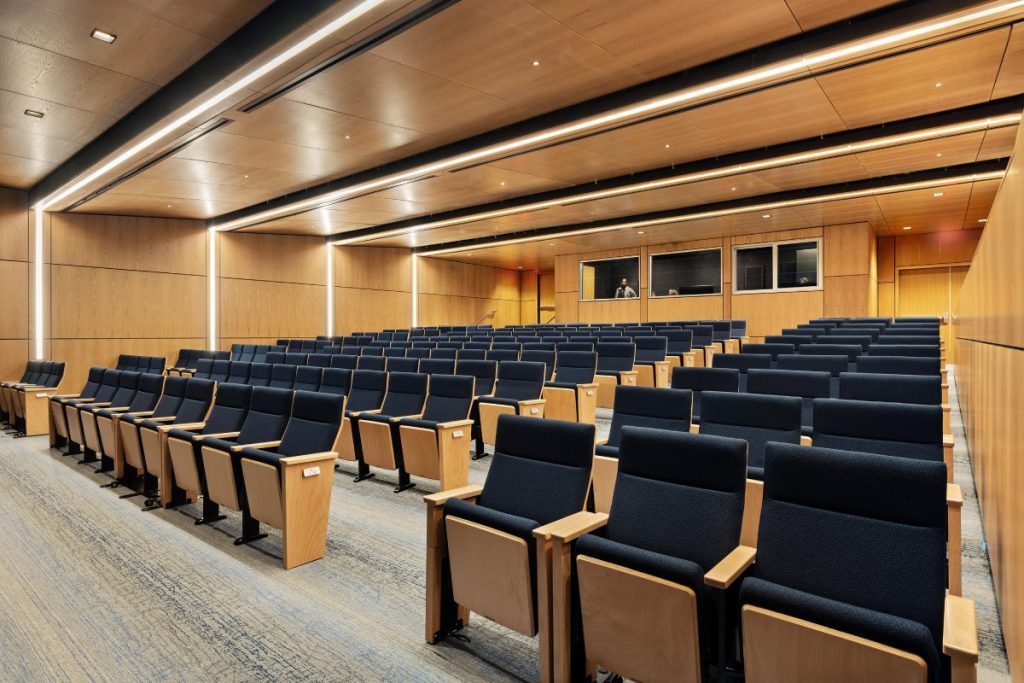
Innovations in Acoustic Metamaterials: Shaping the Future of Architectural Acoustics
Many industries rely on precisely manipulated sound waves in order to achieve a desired result. For instance, in the case of acoustic engineering and sound design, the control of sound waves via building design acoustics and acoustical treatments is intended to provide crystal clear sound. In engineering and manufacturing, sound waves may be manipulated for non-destructive testing of structural integrity of metals, composites, and other materials.
Acoustic metamaterials (AMMs) are proving themselves advantageous to the many industries that rely upon precisely manipulated sound waves to achieve specific outcomes. However, no industrial professionals may see as many benefits as the architects, interior designers, acoustic engineers, and contractors interested in enhancing acoustic performance in architectural spaces.
The purpose of this article is to familiarize you with acoustic metamaterials and the benefits associated with them. You will soon see them in homes and workplaces across the globe, so the more you understand them, the more fully you can enjoy their rewards.
An Introduction to Acoustic Metamaterials
Acoustic metamaterials, or AMMs, are specially engineered, novel materials designed to control and manipulate sound waves in ways that natural materials cannot. They provide superior sound absorption and transmission loss, especially in the case of lower frequencies where traditional acoustical materials typically lack. This is still an emerging field, but the implications on architectural acoustics cannot be overstated.
Acoustic metamaterials are designed to tackle acoustical issues and specific frequencies, which may fall inside or outside the range of traditional acoustic materials like absorptive panels, with a caveat. Many of these materials are designed to absorb a very narrow bandwidth, meaning they are not yet a standalone solution to all acoustical issues. However, when combined with conventional acoustic panels and diffusers, acoustic metamaterials allow acoustical performance beyond the range of those materials to provide advanced sound absorption and transmission loss.
As the field of acoustic metamaterials advances, the bandwidth issue will likely be resolved. Researchers are working on developing metamaterials that have a broader operational bandwidth through a combination of different materials or implementing hierarchical structures that improve broadband performance. This means that the next generation of metamaterials may be able to effectively handle a wide range of frequencies without the need to pair them with conventional acoustic materials.
Applications in Architecture
Acoustic Metamaterials can be integrated into building designs to improve sound quality in various environments, such as restaurants, concert halls, open-plan offices, and residential spaces. There are several architectural projects that have explored the use of acoustic metamaterials to achieve specific acoustic outcomes, including improving sound quality, reducing noise pollution, and enhancing acoustic performance.
Here are two notable examples of how architectural projects have proposed improving acoustical performance through the use of acoustic metamaterials in construction.
1. The Sydney Opera House – Sydney, Australia
Recent research focused on exploring how acoustic metamaterials can be used to refine and optimize sound in this world famous concert hall points to the fact that these materials will soon address specific challenges related to sound clarity and quality in this geometrically challenging space with varied demands. Acoustic metamaterials are capable of affecting very specific frequencies and addressing very specific acoustical issues, making them ideal for treating spaces with unique geometric designs.
2. The Philharmonie de Paris – Paris, France
The Philharmonie de Paris, completed in 2015, is an example in which acoustic metamaterials could be integrated into the design to tremendous effect. This complex of concert halls employs a “variable acoustics” system, which gives them the flexibility to adjust and fine tune the acoustics of the space based on performance type.
By employing metamaterials designed to absorb specific frequencies or direct sound waves to specific areas, they can significantly improve sound quality.
Advantages Over Traditional Acoustic Solutions
Acoustic Metamaterials provide several advantages over traditional acoustic solutions. This is due to the fact that they can control and manipulate sound waves in ways that conventional materials cannot.
Here are some of the top advantages that acoustic metamaterials have over traditional acoustic treatment solutions.
1. Enhanced Sound Control and Manipulation
The fact that acoustic metamaterials target narrow bandwidths allows them to more precisely control the sound quality in any environment. Traditional acoustic materials target much wider bandwidths. As metamaterial technology advances, we will be able to precisely tailor the acoustic properties of any space to meet specific needs, allowing us to control and manipulate sound quality in ways we never dreamed possible.
2. Improved Sound Insulating Ability
Acoustic metamaterials can also be used to improve upon traditional soundproofing techniques. Some of them are designed to serve primarily as soundproofing metamaterials, blocking or absorbing noise with greater efficiency than conventional soundproofing materials. Their ability to provide greater sound isolation without the need for large or bulky structures makes them particularly well-suited to environments like urban settings or near noisy industrial machinery.
3. Compact and Lightweight Design
In tight spaces, like home theater or media rooms, where traditional soundproofing and acoustic materials may take up more space than we would like, metamaterials will prove themselves invaluable. Since they achieve their purpose specifically through design, they can provide similar or better acoustic performance in a much smaller form factor.
4. Directional Sound Control
Some acoustic metamaterials can even be designed to control the directionality of sound waves. This is a vast improvement over diffusers, in that they have the ability to focus sound in specific areas rather than simply scattering them. This is especially helpful in environments such as auditoriums, theaters, and concert halls.
Challenges and Considerations
While implementing acoustic metamaterials into all our construction plans seems incredibly advantageous on multiple fronts, there are some challenges and considerations that will inevitably slow adoption to some extent.
Cost Implications
The first consideration is cost. These materials are still relatively new, and as is the case with most new products, production has not yet reached a point which brings prices down. As of this writing, acoustic metamaterials are still relatively costly, and may be out of reach for consumers working on some smaller projects. Rest assured, acoustic metamaterials show enough promise that this should begin to shift in the coming years and decades.
Scalability
Acoustic metamaterials are most often engineered at very specific scales to achieve their unique acoustical properties. Furthermore, even seemingly identical products may provide slightly different effects if the material property consistency is not one hundred percent identical. These factors can make scalability challenging down the line.
Integration with Existing Construction Methods
If you plan on utilizing acoustic metamaterials as structural elements in your architectural project, their weight and flexibility may pose issues with the rigidity or structural load requirements associated with modern building codes. These materials are currently not standardized as far as installation protocols, material specifications, or testing methods, so it can be challenging for architects, engineers, and contractors to confidently incorporate them for noise reduction in architecture.
Future Outlook
There is a bright outlook for the future of acoustic metamaterials. Various industries require unique solutions in sound manipulation to carry them into the future, including medicine, manufacturing, sound design, and housing. These novel materials represent the next step.
As we have seen through the world-class facilities that are exploring the use of these innovative acoustic materials to improve their acoustics and overall sound, acoustic metamaterials show incredible promise in the world of architectural acoustics. They provide the ability to precisely manipulate sound to improve clarity and prevent sound from traveling outside the venue.
Beyond opera houses and other musical venues, acoustic metamaterials are poised to change the game in multi-tenant housing and commercial spaces. Preventing noise from getting out of hand and leaking into adjoining units is a necessity in areas with growing populations, and acoustic metamaterials will be invaluable in making it happen.
Additionally, the unique properties of acoustic metamaterials can be utilized for creating serene spaces and personalized acoustic environments that give us refuge from the noise of the outside world. Reducing our exposure to noise can make us happier and healthier, which may be the biggest benefit of all.
Shaping the Future of Sound in Your Architecture
The world of acoustic metamaterials is rapidly advancing, and the industry will soon deliver products that absorb sound waves in ways that no material has yet achieved. For those in industries that rely upon solid sound acoustic wave control, this will change the game as we currently understand it.
Keeping on top of advancements in the field will allow business and property owners to get ahead of the game and outperform the competition. ASI Architectural is committed to exploring and sharing knowledge on cutting-edge technologies like acoustic metamaterials that will shape the future of building design as we know it. Follow us for the latest innovations in sound manipulation technologies.






